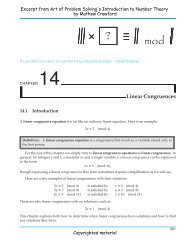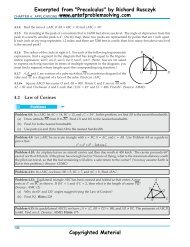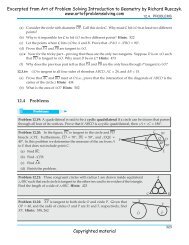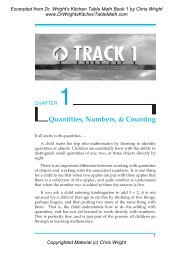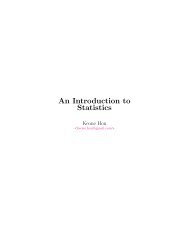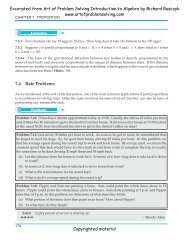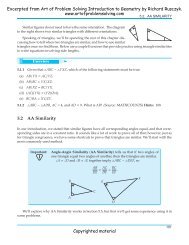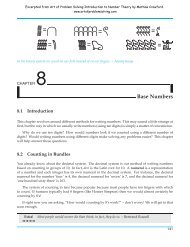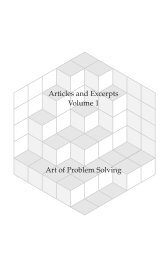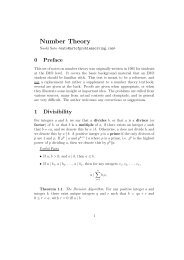Art of Problem Solving Textbooks Do You Know Prealgebra?
Art of Problem Solving Textbooks Do You Know Prealgebra?
Art of Problem Solving Textbooks Do You Know Prealgebra?
You also want an ePaper? Increase the reach of your titles
YUMPU automatically turns print PDFs into web optimized ePapers that Google loves.
<strong>Art</strong> <strong>of</strong> <strong>Problem</strong> <strong>Solving</strong> <strong>Textbooks</strong><br />
<strong>Do</strong> <strong>You</strong> <strong>Know</strong><br />
<strong>Prealgebra</strong>?<br />
This diagnostic test consists <strong>of</strong> two parts, Fundamentals and <strong>Problem</strong> <strong>Solving</strong>. If your<br />
student can solve nearly all <strong>of</strong> the Fundamentals problems and at least half <strong>of</strong> the <strong>Problem</strong><br />
<strong>Solving</strong> problems, then the <strong>Art</strong> <strong>of</strong> <strong>Problem</strong> <strong>Solving</strong> <strong>Prealgebra</strong> text would only serve as a review<br />
for your student. We recommend using the following process to assess whether or not your student<br />
has already mastered the contents <strong>of</strong> the book:<br />
Step 1: The student should attempt all <strong>of</strong> the questions below without a calculator and without<br />
any help. There is no time limit.<br />
Step 2: Check the student’s responses using the answer key at the end <strong>of</strong> this document.<br />
Step 3: The student should be given a second chance on the problems that he or she answered<br />
incorrectly.<br />
1. Exponent basics. Compute:<br />
Fundamentals<br />
(a) 2 5 (b) (−5) 2 − 4 2 (c) 3 0 + 3 −2<br />
2. Exponent laws. Express each <strong>of</strong> the following as a power <strong>of</strong> 2:<br />
(a) 2 4 · 2 3<br />
3. Number Theory basics.<br />
(b) 28<br />
2 4<br />
(a) Find the least common multiple <strong>of</strong> 54 and 24.<br />
(b) Find the greatest common divisor <strong>of</strong> 288 and 684.<br />
(c) Find the least common multiple <strong>of</strong> 72, 120, and 28.<br />
4. Fraction arithmetic. Compute:<br />
(a) 2 7 1<br />
+ −<br />
3 6 4<br />
(b) 3 8 7<br />
· ·<br />
4 5 6<br />
1<br />
(c) 10 ÷ 2<br />
3<br />
(d) 6 1<br />
− 31<br />
4 3<br />
(c) (2 4 ) 3
<strong>Art</strong> <strong>of</strong> <strong>Problem</strong> <strong>Solving</strong> <strong>Textbooks</strong><br />
<strong>Do</strong> <strong>You</strong> <strong>Know</strong><br />
<strong>Prealgebra</strong>?<br />
5. Fraction and Decimal conversion. Convert the following decimals to fractions in simplest<br />
form:<br />
(a) 0.625 (b) 3.64 (c) 0.8<br />
Convert the following fractions to decimals:<br />
(d) 13<br />
4<br />
(e) 7<br />
20<br />
6. Linear Equations. Solve each <strong>of</strong> the following equations:<br />
(a) 3r − 4 = 16 − 7r (b)<br />
7. Ratio and Rates.<br />
2x − 3<br />
5<br />
4 − 3x<br />
=<br />
7<br />
(f) 5<br />
6<br />
(c) 2 − t<br />
�<br />
= 3 5 −<br />
4 t<br />
�<br />
6<br />
(a) The ratio <strong>of</strong> boys to girls at a summer camp is 4 to 5. If the total number <strong>of</strong> students<br />
at the camp is 108, then how many boys are at the camp?<br />
(b) The ratio <strong>of</strong> teachers to students in a particular school is 1 to 11. The ratio <strong>of</strong> female<br />
students to the total number <strong>of</strong> students is 4 to 9. If there are 396 female students, then<br />
how many teachers are there?<br />
(c) A train is traveling 1 mile every 75 seconds. If the train continues at this rate, then how<br />
far will it travel in two hours?<br />
8. Percent.<br />
(a) 18% <strong>of</strong> 50 is what percent <strong>of</strong> 24?<br />
(b) If there are 240 boys in a school with a total <strong>of</strong> 960 students, then what percent <strong>of</strong> the<br />
students are girls?<br />
(c) Katie wants a fancy new music player that costs $300. Katie can buy it in her home<br />
state and pay 8% sales tax, or she can drive to a neighboring state and pay only 5% sales<br />
tax. How much does Katie save on the player if she drives to the neighboring state?<br />
9. Square Roots. Simplify each <strong>of</strong> the following:<br />
(a) √ 81<br />
(b) √ �<br />
(c) 1<br />
144<br />
7<br />
9<br />
√<br />
120<br />
(d) √<br />
3<br />
2<br />
(e) √ 75 + √ 27 − √ 192<br />
(f) 3 √ 18 + 7 √ 8
<strong>Art</strong> <strong>of</strong> <strong>Problem</strong> <strong>Solving</strong> <strong>Textbooks</strong><br />
<strong>Do</strong> <strong>You</strong> <strong>Know</strong><br />
<strong>Prealgebra</strong>?<br />
<strong>Problem</strong> <strong>Solving</strong><br />
10. What is the value <strong>of</strong> the sum 5 + 10 + 15 + · · · + 95 + 100?<br />
11. Express 2 5 · 8 3 · 16 2 as a power <strong>of</strong> 4.<br />
12. The four-digit number A55B is divisible by 36. What is the sum <strong>of</strong> A and B?<br />
13. Two-fifths <strong>of</strong> the students in Central Middle School are boys. One-third <strong>of</strong> the girls have<br />
blond hair and one-quarter <strong>of</strong> the boys have blond hair. What fraction <strong>of</strong> the students in<br />
Central Middle School have blond hair?<br />
14. <strong>Do</strong>uglas writes down his favorite number, which is a two-digit positive integer. He then turns<br />
the number into a three-digit number by writing a 7 at the end <strong>of</strong> his favorite number. This<br />
new number is 385 more than <strong>Do</strong>uglas’s favorite number. What is <strong>Do</strong>uglas’s favorite number?<br />
15. Kayla adds the same number to both the numerator and denominator <strong>of</strong> the fraction 1<br />
10 . Her<br />
resulting fraction equals 2<br />
3 . What number did she add to both the numerator and denominator<br />
<strong>of</strong> her original fraction?<br />
16. Five workers together can build a road in 20 days. Suppose every worker works at the same<br />
rate. Three workers work on the road for 10 days before eleven more workers join them. How<br />
much longer will it take the fourteen workers to finish the road?<br />
17. A northbound train from Miami to Jacksonville made the 324-mile journey at an average<br />
speed <strong>of</strong> 50 miles per hour. On its southbound return trip, it made the journey at an average<br />
speed <strong>of</strong> 40 miles per hour. To the nearest tenth <strong>of</strong> a mile per hour, what was the train’s<br />
average speed for the 648-mile roundtrip journey?<br />
18. At Annville Junior High School, 30% <strong>of</strong> the students in the Math Club are in the Science<br />
Club, and 80% <strong>of</strong> the students in the Science Club are in the Math Club. There are 15<br />
students in the Science Club. How many students are in the Math Club?<br />
3
The answers to <strong>Do</strong> <strong>You</strong> <strong>Know</strong> <strong>Prealgebra</strong> are below.<br />
1. (a) 32; (b) 9; (c) 1 1<br />
9<br />
2. (a) 2 7 ; (b) 2 4 ; (c) 2 12<br />
or 10<br />
9<br />
3. (a) 216; (b) 36; (c) 2520<br />
4. (a) 19<br />
12<br />
5. (a) 5 91<br />
; (b)<br />
8 25<br />
7 7<br />
or 1 ; (b) ; (c) 15; (d) 211<br />
12 5 12<br />
<strong>Art</strong> <strong>of</strong> <strong>Problem</strong> <strong>Solving</strong> <strong>Textbooks</strong><br />
<strong>Do</strong> <strong>You</strong> <strong>Know</strong><br />
<strong>Prealgebra</strong>?<br />
or 35<br />
12<br />
8<br />
or 316;<br />
(c) ; (d) 3.25; (e) 0.35; (f) 0.83<br />
25 9<br />
6. (a) r = 2; (b) x = 41<br />
; (c) t = 52<br />
29<br />
7. (a) 48 boys; (b) 81 teachers; (c) 96 miles<br />
8. (a) 37.5%; (b) 75%; (c) $9<br />
9. (a) 9; (b) 12; (c) 4<br />
3<br />
10. 1050<br />
11. 4 11<br />
12. 8<br />
13. 3<br />
10<br />
14. 42<br />
15. 17<br />
16. 5 days<br />
17. 44.4 miles per hour<br />
18. 40<br />
or 1 1<br />
3 ; (d) 2√ 10; (e) 0; (f) 23 √ 2<br />
c○ 2011 AoPS Incorporated. All rights reserved.<br />
4



